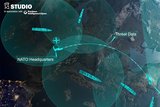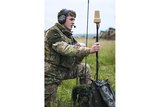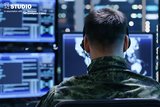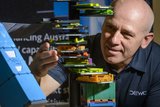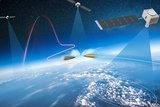Digital engineering: a new era of manufacturing (Studio)
Brought to you in partnership with Raytheon Intelligence & Space
The power of digital engineering in defence manufacturing was dramatically underscored in late 2020 when the US Air Force (USAF) demonstrated its Next Generation Air Dominance (NGAD) fighter aircraft.
Such technology has the potential to significantly reshape the design and production process, touching everything from fighter aircraft to satellite design, according to Raytheon Intelligence & Space (RIS).
In September 2020, Dr. Will Roper, then the USAF assistant secretary for acquisition, technology and logistics, said that digital engineering had allowed the service to design, assemble, test and fly NGAD in record time.
As part of the same speech to the Air Force Association’s 2020 Virtual Air, Space, and Cyber conference, Roper called for ‘disruptive agility’, pointing to the need for acquisition agility based on digital engineering to disrupt US adversaries.
Mark Davis, a missions system architect in the Space Systems group within Raytheon Intelligence & Space, spent 25 years in the US Air Force before joining the defence and aerospace giant.
He’s witnessed the development of the digital engineering concept over the decades and the move towards an environment where a single, digital source of truth empowers defence manufacturing.
For example, take the concept of ‘Digital Twins’, computer-generated models of real-life platforms and systems that evolve over time, allowing operators to test specific changes and interrogate the impact they would have in reality.
Now, ‘we’re talking about a real revolution of putting it all together in one environment that everybody can interrogate at the same time, including our customers, as well as our engineers’, he explained.
The customer dimension is one of the most significant factors behind the rise of digital engineering, said Madison Dye, an RIS systems engineer for space and command and control (C2) systems.
Dye is part of one of many teams at Raytheon focused on a suite of approaches known as digital transformation, of which digital engineering is a key component.
The broader effort includes investments in transforming development processes, contracting and business models, manufacturing and critical mission capabilities. The idea is to engrain a more integrated mindset into the culture, and cultivate digital engineering capabilities, agile software development methods, and business models that allow commercial companies to move so quickly.

The business is building an environment to further enable this transformation. This transformation allows the business to develop and deploy new mission capabilities faster than ever before.
Because everything developed is designed to be open, digital transformation will enable customers to seamlessly operate across every domain, sharing and exploiting data just as quickly as it can be collected.
Ultimately, it’s no longer a case of pursuing what industry thinks is best but instead taking a more iterative, through-life approach to achieving what the customer wants, something that digital engineering supports.
‘That’s how they want to see things done going forward,’ Davis said.
Turning to the specific benefits of digital engineering, Davis said Raytheon delivers its designs digitally, making them far easier to comprehend and review.
He said that mission performance assessment is a significant part of his role, with a group of engineers conducting modelling and simulations and assessing technological performance in realistic mission scenarios.
By placing such work into the digital environment, the engineers can quickly understand the impact of a change through the requirements and design phases, all the way to build and operations.
They can now see ‘how that ripples through the system to mission performance’, something that in the past would have taken months to establish and require many engineers conducting paper analysis.
‘Now we’re able to turn that full crank to show how change will impact the overall cost schedule and performance of the system,’ he said. ‘That used to be a long process – we can do it quickly now.’
Davis noted this has real-world implications, empowering the US to quickly respond to evolving threats at any point in a programme’s development.
‘We can’t afford to have ten-year programmes that never change for those ten years,’ he said. ‘We need to be able to change them in the design if we need to.’
For instance, in the space systems domain, that with better use of digital engineering and twins, the company can architect in a manner such that there is segregation between elements of the design and with that understanding, they can isolate changes, assess impacts quicker, and facilitate more/faster changes.
‘That’s a huge benefit to our customers.’

The benefits of working in a digital environment have been highlighted by the Covid-19 pandemic, particularly in unclassified work.
Raytheon has conducted a high level of work based on employees working from home, said Davis. ‘The infrastructure behind that has really helped speed things up.’
There has been a growing cultural change, Dye said, with digital transformation at the heart of the journey.
Of course, digital engineering isn’t just for engineers, Dye added.
‘Digital Transformation isn’t about doing the same thing a little bit faster. It’s about reinventing our business to move faster than ever and continue to set the bar for our ability to deliver the disruptive technologies our customers need to succeed in any domain, against any challenge,’ he explained.
Raytheon has detailed discussions with employees in a range of roles about the applications of digital transformation, using ‘a lot of amazing digital tools and processes that [utilise] our cost-modelling capabilities’.
‘We’re able to disseminate that information to the programme leadership so that we’re able to make better cost, technology and scheduling decisions going forward.’
More from Space Solutions Special Report
-
![Delivering Space Solutions - the Crucial Layer for Missile Defence (video)]()
Delivering Space Solutions - the Crucial Layer for Missile Defence (video)
Against the backdrop of rising ‘peer’ and regional state rivals, the role of space-based assets for effective missile defence will be critical.
-
![Why space-based assets are crucial for effective missile defence (Studio)]()
Why space-based assets are crucial for effective missile defence (Studio)
Adding a space layer to missile defence is not an optional extra – it is crucial.
-
![British Army embraces SlingShot]()
British Army embraces SlingShot
Add-on kit turns UHF/VHF radio into a BLoS solution to support voice and data communications.
-
![Delivering Space Solutions - the New Digital Engineering Paradigm (video)]()
Delivering Space Solutions - the New Digital Engineering Paradigm (video)
Digital engineering is transforming the defence industry, from design to manufacturing.
-
![DEWC Systems takes MOESS sensor development to next stage]()
DEWC Systems takes MOESS sensor development to next stage
The MOESS programme intends to deploy a sovereign Australian tactical electromagnetic sensor capability, installed on a constellation of CubeSats. DEWC is developing a sensor that can conduct radar electronic support in defence-relevant radio frequency bands used by assets such as ships and aircraft.
-
![MDA unlocks key challenge to advanced ballistic missile tracking]()
MDA unlocks key challenge to advanced ballistic missile tracking
The US is progressing with its HBTSS project, having overcome an important obstacle.











